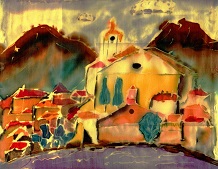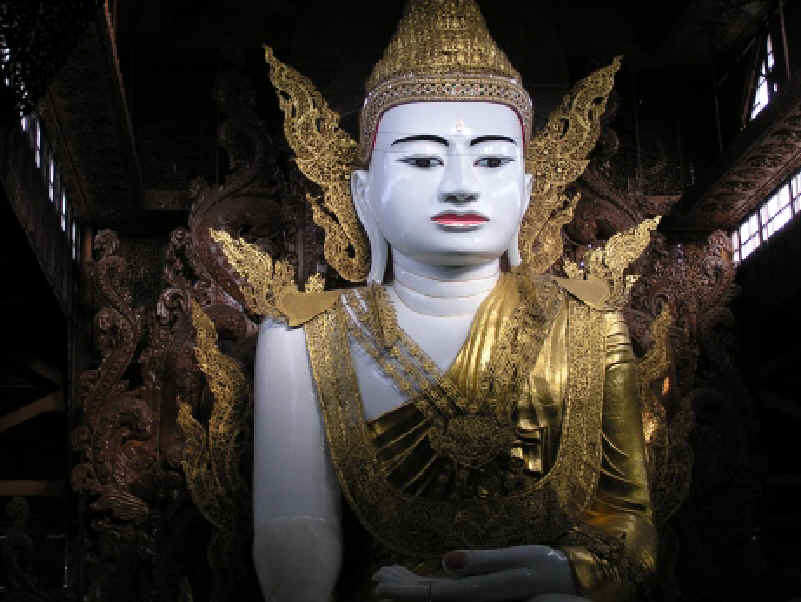|
Myanmar (Burma) is a deeply Buddhist country, with Theravada
Buddhism being the predominant religion. Buddhism
plays a central role in the culture, daily life, and traditions of the
people. The country is home to countless pagodas,
temples, and monasteries, many of which are significant
pilgrimage sites. Here are some key aspects of Buddhism in Myanmar and
notable Buddhist sites:
Buddhism in Myanmar
-
Theravada Buddhism: Myanmar follows the Theravada
tradition, which emphasizes the original teachings of the Buddha and
the importance of monastic life.
-
Monks and Nuns: Monks (Bhikkhus) and nuns
(Thilashins) are highly respected in society. Many young boys
undergo temporary monastic ordination as a rite of passage.
-
Festivals: Major Buddhist festivals, such as Thingyan
(Water Festival) and Kathina
(robe-offering ceremony), are celebrated with great
enthusiasm.
-
Daily Practices: Many Myanmar people engage in
daily rituals like offering food to monks, meditating, and visiting
pagodas to pray and make merit.
Famous Buddhist Sites in Myanmar
-
Shwedagon Pagoda (Yangon):
-
The most iconic and sacred site in Myanmar, believed to enshrine
relics of four Buddhas, including strands of the Buddha's hair.
-
The golden stupa is visible from much of Yangon and is a
must-visit for pilgrims and tourists.
-
Bagan:
-
Home to over 2,000 ancient temples and
pagodas, Bagan is a UNESCO World Heritage Site and a
testament to Myanmar's rich Buddhist heritage.
-
Notable temples include Ananda Temple, Shwezigon
Pagoda, and Dhammayangyi Temple.
-
Mandalay and Surroundings:
-
Maha Myat Muni Pagoda: Houses a highly revered
Buddha image believed to be one of only five likenesses of the
Buddha made during his lifetime.
-
Kuthodaw Pagoda: Known as the "World's Largest
Book," it features 729 marble slabs inscribed with Buddhist
scriptures.
-
Golden Rock (Kyaiktiyo Pagoda):
-
A gravity-defying golden boulder perched on the edge of a cliff,
said to be balanced by a strand of the Buddha's hair.
-
A major pilgrimage site, especially for men (women are not
allowed to touch the rock).
-
Inle Lake:
-
Monywa:
Buddha Statues in Myanmar
Myanmar is famous for its large and impressive Buddha statues,
including:
-
Laykyun Sekkya: The second-tallest Buddha statue in
the world, standing at 116 meters (381 feet), located near Monywa.
-
Reclining Buddha (Chaukhtatgyi Pagoda, Yangon): A
massive 65-meter-long reclining Buddha image.
-
Standing Buddha (Hsinbyume Pagoda, Mingun): A
striking white-painted Buddha statue.
Buddhist Practices and Etiquette for Visitors
-
Dress Modestly: When visiting temples and pagodas,
wear clothing that covers your shoulders and knees.
-
Remove Shoes and Socks: It is customary to remove
footwear before entering sacred sites.
-
Respect Monks and Nuns: Avoid touching them
(especially if you're a woman) and always show reverence.
-
Circumambulate Stupas: Walk around pagodas and
stupas in a clockwise direction as a sign of respect.
Buddhism is deeply woven into the fabric of Myanmar's identity, and
exploring its sacred sites offers a profound insight into the country's
spiritual and cultural heritage. Whether you're a pilgrim, a history
enthusiast, or a curious traveler, Myanmar's Buddhist landmarks are sure
to leave a lasting impression.
In Myanmar, the
Buddha holds immense
cultural, spiritual, and historical significance. Buddhism is the
predominant religion in Myanmar, and
Buddhist teachings and practices
deeply influence daily life and traditions. The country is home to some
of the most impressive Buddhist
statues, pagodas, and temples in the world, making it a
significant destination for those interested in exploring the heritage
of Buddhism.
Buddhism in Myanmar:
Buddhism in Myanmar is primarily of
the Theravada school,
which is considered the oldest form of Buddhism. Theravada Buddhism
emphasizes the Pali Canon,
a collection of scriptures considered the authentic teachings of the
Buddha. The religion focuses on practices such as meditation, ethical
conduct, and the pursuit of enlightenment (Nirvana).
Famous Buddha Statues and Sites
in Myanmar:
-
Shwedagon Pagoda (Yangon):
- The
Shwedagon Pagoda
is the most iconic Buddhist site in Myanmar and one of the
holiest places in the country. The pagoda is said to house
relics of the Buddha,
including strands of his hair.
- It stands at over
99 meters in
height and is covered in
gold leaf,
making it an extraordinary sight, especially when lit up at
night. The pagoda is surrounded by hundreds of smaller stupas
and statues of the Buddha.
-
Reclining Buddha at
Kyaukhtatkyi Pagoda (Yangon):
- The
Kyaukhtatkyi Pagoda
is home to a large
reclining Buddha statue that stretches over
66 meters.
The statue represents the Buddha in the position he is believed
to have been in when he passed away, symbolizing his peaceful
transition into Nirvana.
-
**The Buddha at the
Uppatasanti Pagoda
(Naypyidaw):
- The
Uppatasanti Pagoda
is home to one of the largest Buddha statues in Myanmar, known
as the "Great Buddha".
The statue stands over
30 meters tall and is a key feature of the
Uppatasanti Pagoda,
which is modeled after the Shwedagon Pagoda.
-
The Buddha at Kyaiktiyo
Pagoda (Golden Rock):
- The
Kyaiktiyo Pagoda,
also known as the
Golden Rock, is one of the most famous pilgrimage sites
in Myanmar. The golden
rock appears to be precariously balanced on the edge of
a mountain and is said to be held in place by a Buddha's hair.
- Pilgrims make their way to
the site to pay respects to the
Buddha's relic
housed in the pagoda and to witness the miraculous sight of the
floating rock.
-
Ananda Temple (Bagan):
- The
Ananda Temple
in Bagan is
one of the most revered and historically important temples in
Myanmar. The temple houses four large, seated Buddha statues,
each facing a different direction.
- The temple's design
reflects the architectural beauty of
11th-century Bagan,
and the Buddha statues inside are depicted in serene, meditative
postures.
-
Buddha Statues of Bagan:
- The ancient city of
Bagan is home
to thousands of temples, pagodas, and statues of the Buddha,
most of which were built between the
9th and 13th centuries.
Some of the most famous Buddha statues include those at the
Shwezigon Pagoda,
Thatbyinnyu Temple,
and Dhammayangyi
Temple.
- The statues are often
depicted in the
meditation position (Dhyana Mudra) or standing,
symbolizing various aspects of the Buddha’s life.
-
Buddhist Pilgrimage Sites:
- Myanmar is home to
numerous pilgrimage
sites where Buddhists travel to venerate the Buddha and
earn merit. These sites include the
Mahasi Meditation
Center and
Sagaing Hill in central Myanmar, where monks and
laypeople meditate and study the teachings of the Buddha.
Buddhist Practices in Myanmar:
-
Meditation:
- Meditation is central to
Buddhist practice in Myanmar. The country is home to several
meditation centers
where people come from all over the world to practice under the
guidance of experienced monks.
- The most famous method is
the Vipassana
meditation (insight meditation), which focuses on
developing awareness and understanding of the impermanence of
life.
-
Monastic Life:
- Many young men in Myanmar
spend part of their life in a monastery as monks.
Monastic life
is a respected and important tradition, with monks playing a
significant role in the community by offering teachings,
blessings, and prayers.
-
The Sangha:
- The
Sangha is the
community of ordained monks and nuns who are responsible for
preserving and teaching the Buddha’s teachings. The Sangha plays
a central role in Myanmar society and is highly respected by
laypeople.
-
Offerings and Pujas:
-
Buddhist offerings
(such as flowers, incense, candles, and food) are common
practices at temples and pagodas. People make offerings to show
respect for the Buddha and to gain spiritual merit.
-
Pujas
(devotional ceremonies) are conducted by monks and laypeople to
honor the Buddha and pray for the well-being of loved ones.
-
Buddhist Festivals:
- Myanmar celebrates various
Buddhist festivals,
such as Thingyan
(Myanmar’s New Year), which is marked by water celebrations, and
Thadingyut
(Festival of Lights), during which people honor the Buddha’s
descent from heaven.
In conclusion, the Buddha
holds a revered place in Myanmar’s religious and cultural life, with an
abundance of temples, pagodas, and statues scattered across the country.
These sacred sites, alongside daily Buddhist practices such as
meditation and offerings, reflect the deep spiritual connection the
people of Myanmar have with
Buddhism. Whether visiting the grand
Shwedagon Pagoda in
Yangon or exploring the ancient temples of
Bagan, the presence
of the Buddha is felt throughout Myanmar, offering a profound and
peaceful experience for travelers and pilgrims alike.
|
|
 Safaris
Bergsteigen
Wandern
Inselwandern Weltweit
Safaris
Bergsteigen
Wandern
Inselwandern Weltweit
 Europa
Inselwandern
Europa
Inselwandern
 Städtewandern
Städtewandern
 Paintings
Paintings Dirk Rauschenbach
Dirk Rauschenbach
 Safaris
Bergsteigen
Wandern
Inselwandern Weltweit
Safaris
Bergsteigen
Wandern
Inselwandern Weltweit
 Europa
Inselwandern
Europa
Inselwandern
 Städtewandern
Städtewandern
 Paintings
Paintings Dirk Rauschenbach
Dirk Rauschenbach

![]() 26.07.25 Copyright Dirk
Rauschenbach Koelnerstrasse 293 51702 Bergneustadt
Datenschutzerklaerung 02261 9788972 Mail ccooly(
at) web.de
26.07.25 Copyright Dirk
Rauschenbach Koelnerstrasse 293 51702 Bergneustadt
Datenschutzerklaerung 02261 9788972 Mail ccooly(
at) web.de